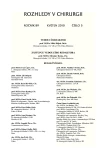Aneuryzma abdominální aorty – dlouhodobé výsledky léčby
Authors:
V. Třeška; B. Čertík; V. Kuntscher; R. Šulc; J. Moláček; K. Houdek; F. Šlauf *; M. Novák *; Inka Třešková; A. Ňaršanská
Authors‘ workplace:
Chirurgická klinika FN a LF UK v Plzni, přednosta: prof. MUDr. Vladislav Třeška, DrSc.
; Radiodiagnostická klinika FN a LF UK v Plzni
*
Published in:
Rozhl. Chir., 2010, roč. 89, č. 5, s. 300-305.
Category:
Monothematic special - Original
Overview
Objective:
To evaluate the single center experience in the treatment of patients with AAA.
Methods:
586 patients undergoing open resection (OR) and EVAR (2000–2009). The average age was 72.2 Ī 7.7 years. AAA diameter was 8.3 cm (range 5.0–13.1cm). 451 (76.9%) patients had asymptomatic AAA, 135 (23.1%) RAAA. 448 patients (76.5%) suffered from various co-morbidities. 430 (73.4 %) OR, 156 (26.6%) EVAR and 52 (8.9%) one staged procedure (for concomitant diseases) was performed.
Results:
30 days mortality rate of elective OR and EVAR was 6.2, resp. 2.9% (n.s.) versus 36.6% of RAAA (p < 0.0001). 30 days mortality rate of one staged and single procedure was 19.5, resp. 3.6% (p < 0.0001). 30 days morbidity rate was in the whole group 52.1% (80.7% in RAAA x 43.4% in asymptomatic AAA – p < 0.0001), in one-stage procedures 60.8% x 51.1% in single procedures – n.s., 45.1% in OR x 39.0% in EVAR – n.s. Redo procedures were significantly higher in EVAR x OR in the long-term period after primary procedure. 1-, 3-, 5-, and 8 years survival of patients with asymptomatic AAA and RAAA was 91.6, 85.9, 81.1 and 73.6%, resp. 54.9, 48.9, 45.9 and 43.5 years (p < 0.0001). 1-, 3-, and 5 years patients survival with single versus one staged procedures was 85.5, 80.5 and 71.0% versus 71.1, 68.0 and 74.6% (n.s.). 1-, 3-, and 5 - years patients survival after OR or EVAR was 91.2, 87.1 and 80.6%, resp. 90.7, 79.9 and 74.6 % (n.s.). The significant influence on patients long-term survival had RAAA, age of patients, postoperative complications and one stage procedures.
Conclusion:
High percentage of polymorbidity was the cause of the significant 30days postoperative mortality of patients after OR. EVAR and OR have similar long-term results. One staged procedures should be used very carefully in selected patients due to the higher mortality rate and worse long-term patients survival.
Key words:
abdominal aortic aneurysm – treatment – long-term results
Sources
1. Sakalihasan, N., Limet, R., Defawe, O. D. Abdominal aortic aneurysma. Lancet, 2005, 365 : 1577–1589.
2. Symons, N. R., Gibbs, R. G. The management of abdominal aortic aneurysma. Br. J. Hosp. Med. (Lond), 2009, 70 (10): 566–571.
3. Diehm, N. Abdominal aortic aneurysma. Internist (Berl), 2009, 50(8): 972–978.
4. Krizkova, V., Korabecna, M, Kocova, J, Treska, V., Molacek, J, Tonar, Z., Tolinger, P, Nedorost, L. Quantification of plasminogen activator inhibitor type 1 in the aortic wall. International Angiology, 2009, 28 (1): 44–49.
5. Molacek, J., Treska, V., Kobr, J., Certik, B., Skalicky, T., Kuntscher, V., Krizkova, V. Optimization of the model of abdominal aortic aneurysm experiment in an animal model. J. Vasc. Surg. Res., 2009, 46 (1): 1–5.
6. Towne, J. B. Endovascular treatment of abdominal aortic aneurysma. Am. J. Surg., 2005, 189 (2): 140–149.
7. van Damme, H., Creemers, E., Defraigne, J. O. Endovascular aneurysma repair (EVAR): does it fulfil all its promises? Acta Chir. Belg., 2009, 109(4): 436–443.
8. Teufelsbauer, H., Polterauer, P., Lammer, J., Huk, I., Nanobachvili, J., Kretchmer, G. Repair of abdominal aortic aneurysms: the benefits of offering both endovascular and open surgical techniques. Perspect Vasc. Surg. Endovasc. Ther., 2006, 18(3): 238–246.
9. Marine, M. L., Valdes, E. F., Mertens, M. R., Kramer, Sch. A., Bergoeing, R. M., Rivera, D. D., Vergara, G. J., Carvajal, N. C. Open and endovascular Sumery for the treatment of abdominal aortic aneurysma.Review of the available evidence. Rev. Med. Chill., 2009, 137(8): 1081–1088.
10. Chambers, D., Fayter, D., Paton, F., Woolacott, N. Use of non-rendomised evidence alongside randomised trials in a systematic review of endovascular aneurysma repair: strenghts and limitations. Eur. J. Vasc. Endovasc. Surg., 2010, 39(1): 26–34.
11. Piffaretti, G., Caronno, R., Tozzi, M., Lomazzi, C., Rivolta, N., Castelli, P. Endovascular versus open repair of ruptured abdominal aortic aneurysms. Expert Rev. Cardiovasc. Ther., 2006, 4(6): 839–852.
12. Chaikof, E. L., Brewster, D. C., Dalman, R. L., Makaroun, M. S., Illig, K. A., Sicard, G. A., Timaran, C. H., Upchurch, G. R. Jr., Veith, F. J. The care of patiens with an abdominal aortic aneurysma: the Society for Vascular Surgery practice quidelines. J. Vasc. Surg., 2009, 50(4 Suppl), S2–49.
13. Wilson, W. R., Choke, E. C., Dawson, J.,Loftus, I. M., Thompson, M. M. Contemporary management of the infra-renal abdominal aortic aneurysms. Surgeon, 2006, 4(6): 363–371.
14. Čertík, B., Třeška, V., Kuntscher, V., Moláček, J. Chirurgické řešení synchronního výskytu aneuryzmatu břišní aorty a nádorů ledvin na chirurgické klinice FN v Plzni v letech 2006 a 2007. Rozhl. Chir., 2008, 87(12): 639–642.
15. Miller, A., Marotta, M., Scordi-Bello, I., Tammaro, Y., Marin, M., Divino, C. Ischemic colitis after endovascular aortoiliac aneurysma repair: a 10-year retrospective study. Arch. Surg., 2009, 144(10): 900–903.
Labels
Surgery Orthopaedics Trauma surgeryArticle was published in
Perspectives in Surgery

2010 Issue 5
Most read in this issue
- The Role of Hartmann’s Procedure and Options for its Reconstruction at the Present Time
- Buried Bumper Syndrome (BBS) as a Complication of Percutaneous Endoscopic Gastrostomy
- Komplikace hojení ran u kuřáků
- Neurogenic Bladder Therapy in Patients with Spinal Dysraphism. Actual Strategy
